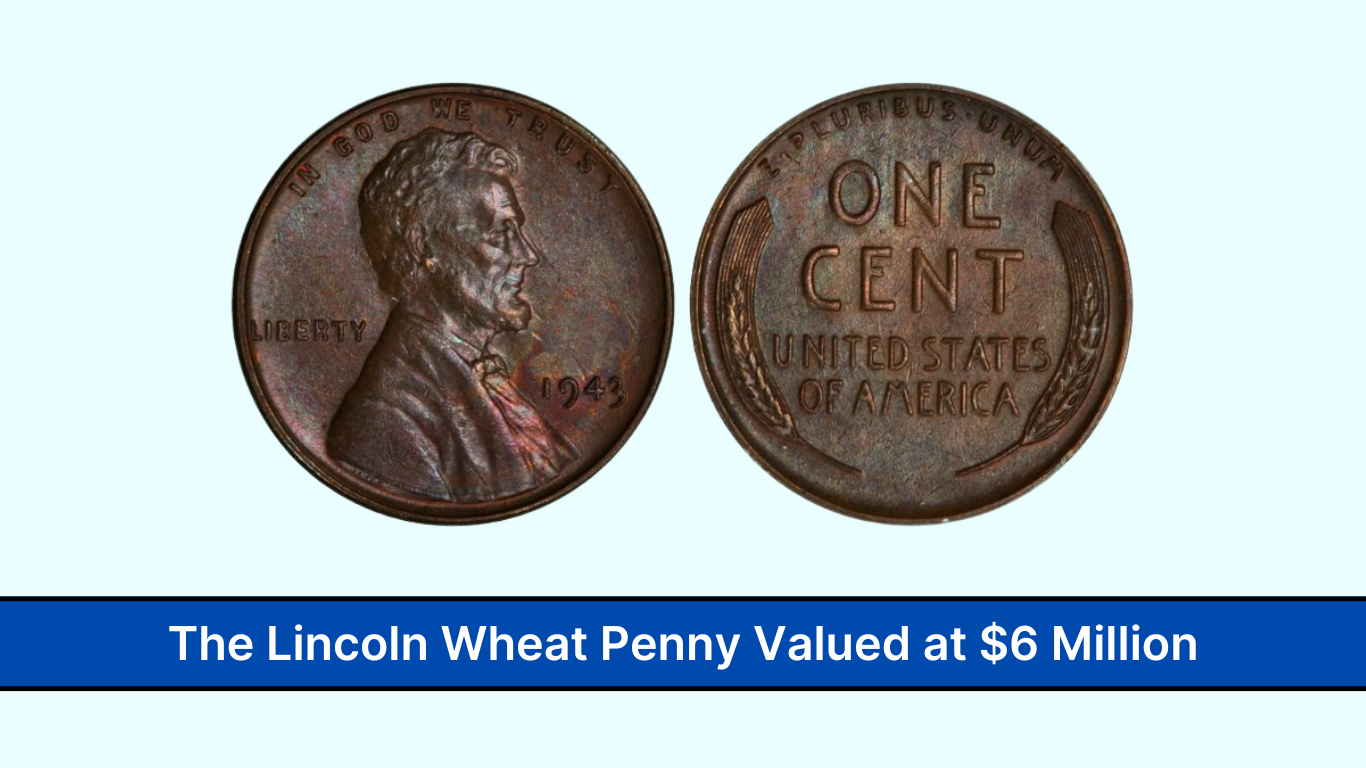Most people overlook pennies, considering them insignificant in today’s economy. However, certain Lincoln Wheat Pennies have defied expectations, with rare specimens fetching up to $6 million at auction. This remarkable valuation turns a humble one-cent coin into one of the most sought-after treasures in coin collecting.
In this article, we’ll explore the fascinating history of the Lincoln Wheat Penny, the legendary 1943 copper penny, and other rare pennies that might still be hiding in pocket change today.
The Birth of the Lincoln Wheat Penny
The Lincoln Wheat Penny was first minted in 1909 to commemorate the 100th anniversary of Abraham Lincoln’s birth. It marked a significant change in U.S. coinage, as it was the first U.S. coin to feature a real historical figure rather than an allegorical representation like Lady Liberty.
Key Features of the Lincoln Wheat Penny (1909–1958):
- Obverse (Front): A portrait of President Abraham Lincoln
- Reverse (Back): Two wheat stalks framing the words “ONE CENT” and “UNITED STATES OF AMERICA”
- Composition: 95% copper (except for the steel pennies of 1943)
The Wheat Penny was produced from 1909 to 1958, witnessing significant moments in history, including both World Wars, the Great Depression, and the early years of the Cold War. Though common, certain rare variations can be worth a small fortune today.
The $6 Million Lincoln Wheat Penny – A Wartime Minting Mistake
The most valuable Wheat Penny ever sold is the 1943 Copper Lincoln Penny, which has been valued at up to $6 million. This coin exists because of an unusual mistake during World War II.
Why Is the 1943 Copper Penny So Valuable?
During the war, copper was a critical material needed for ammunition and military supplies. As a result, the U.S. Mint switched to producing pennies from steel in 1943 to conserve copper for the war effort. These steel pennies had a silvery appearance and are still commonly found today.
However, a few leftover copper planchets (coin blanks) from 1942 were accidentally used to strike a small number of 1943 pennies. These rare 1943 copper pennies—with an estimated fewer than 20 in existence—are now some of the most valuable coins in the world.
Notable Sales of the 1943 Copper Penny:
- $1.7 million – A near-perfect specimen was sold at auction in 2010.
- $6 million – A record-breaking private sale valued the penny at this amount.
How to Identify a 1943 Copper Penny
If you believe you have a 1943 penny, here’s how to determine if it could be the rare copper version:
Check the Date: Look for 1943—this is the key year for the most valuable variation.
Test with a Magnet: Steel pennies are magnetic, while the rare copper versions are not.
Weigh the Coin:
- Copper Penny: 3.11 grams
- Steel Penny: 2.7 grams
If your 1943 penny is copper and non-magnetic, it could be worth millions! It’s crucial to get it authenticated by professional grading services like PCGS (Professional Coin Grading Service) or NGC (Numismatic Guaranty Corporation).
Other Valuable Lincoln Wheat Pennies
While the 1943 copper penny is the most valuable, several other Wheat Pennies can fetch impressive prices.
1. 1909-S VDB Lincoln Penny – Worth Over $100,000
- Features designer Victor David Brenner’s initials (“VDB”) on the reverse.
- Quickly removed due to public criticism, making it one of the scarcest Wheat Pennies.
- Only 484,000 were minted in San Francisco.
Look for: A small “S” mint mark and “VDB” on the reverse.
2. 1914-D Lincoln Penny – Valued Over $5,000
- Only 1.2 million were minted in Denver.
- Many were lost or heavily circulated, making high-grade examples extremely rare.
Look for: A “D” mint mark beneath the date.
3. 1922 “Plain” Lincoln Penny – Worth Over $10,000
- Produced in Denver, but some coins lack the “D” mint mark due to worn dies.
- This rare error variety commands high prices among collectors.
Look for: A missing mint mark (no “D”) on a 1922 penny.
4. 1955 Doubled Die Lincoln Penny – Valued Up to $125,000
- Caused by a misalignment during the die-making process, resulting in a dramatic doubling of the date and lettering.
- One of the most famous and sought-after error coins.
Look for: A clear doubling effect on “LIBERTY” and “IN GOD WE TRUST.”
Could Million-Dollar Pennies Still Be in Circulation?
Yes! While rare, valuable Lincoln Wheat Pennies can still be found in old collections, inherited coin jars, and even pocket change.
Why are rare pennies still out there?
- Many people don’t know about rare pennies, so they unknowingly spend them.
- Old coin collections are often cashed in without being checked for rare dates.
- Some rare pennies were set aside decades ago and might reappear in circulation.
One incredible example is a 1943 copper penny discovered in 2019 by a Massachusetts family. The father had unknowingly saved a million-dollar coin for decades without realizing its value.
Protecting Yourself from Counterfeits
Due to their high value, rare Lincoln Wheat Pennies are frequently counterfeited. Here’s how to avoid fakes:
Avoid Online Scams – Buy and sell only through reputable coin dealers or auction houses.
Use Simple Tests – A magnet test can quickly identify a fake 1943 copper penny.
Get Professional Grading – Use services like PCGS or NGC to verify authenticity and condition.
What to Do If You Find a Rare Wheat Penny
If you think you’ve found a valuable Wheat Penny, follow these steps:
Handle the coin carefully – Hold it by the edges to avoid damage.
Verify authenticity – Perform the magnet and weight tests for key dates like 1943.
Have it graded – Professional authentication can significantly increase the coin’s value.
Sell through reputable sources – Consider auction houses, coin dealers, or online marketplaces like Heritage Auctions.
FAQs
A genuine copper 1943 penny is non-magnetic and weighs 3.11 grams.
Yes! Some rare pennies have resurfaced in recent years, often found in old collections.
Get it graded by PCGS or NGC, then sell through trusted auction houses or coin dealers.
Verify its authenticity, store it carefully, and consult a professional coin grading service.

